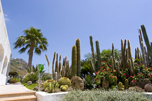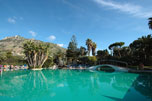Description
The church, located over 400 meters above sea level, is located in a natural setting of great charm and beauty, between forests, hiking trails, terraces and stone houses, ancient shelters for shepherds and farmers. Partially excavated in the tufa rock, this "church of stone" can be considered a typical example of mountain architecture. The building structure is very simple. The large courtyard in front of the stone benches, and presents an enormous cistern dug in the tuff for collecting rainwater. The facade is very simple simple, is topped by a rectangular structure with two bells and a spherical dome. The interior has a large central nave ending in the apse, flanked on the right side by a narrow aisle. In addition to the altarpiece depicting the Madonna with the anonymous saints Anthony Abbot and Paul the Hermit, the church has a wooden altar frontal with painted floral motifs, from the early seventeenth century, and residues of frescoes of the seventeenth century …Hitorical info
In his work, D’Ascia (1867) reports the news that the church was built in 1596 by Sebastian Sportiello to atone for a murder. Sportiello belonged to the family who was also the foundation of the church of S. Charles, another example of rural architecture in the front that reveals an affinity with the church of S. Maria al Monte. Based on the testimony of some descendants of the family, D’Ascia said that the three Sportiello brothers (Sebastiano, Vito Nicola and Andrea), rich landowners in Salerno, escaped to Forio after killing the bishop of their city, for penance, they were forced to build two churches at less distance from each other. D'Arbitrio e Ziviello (1982) speculate that the church was built by local people when agriculture and then spread to rural settlements in the mountainous areas. The church, built in a strategic position, became a reference point for the farming communities settled in those areas, meeting their religious needs, and social practices. S. Maria al Monte was considered as place of worship designed to preserve the traditions of the religious population, but also a meeting point, meeting and gathering in case of danger. The church was abandoned around 1930 and used as a shelter for animals and storage of wood until, for the initiative of a former Monaco of the S. Nicholas Hermitage on Epomeo, thanks to the donations collected from the faithful Forian people, was reopened and restored. There was a great opening party and since then St. Maria del Monte has become a place of pilgrimage for the holiday celebrated every year on September 12, in which is carried in procession a statue of the Madonna. A legend in the oral tradition recorded in Forio in 1990 (Vuoso, 2002, pp. 84-85) associates the church to the pirate raids which plagued the island between the sixteenth and the eighteenth century: a Forian fisherman was driven by a storm in Turkey where he was captured by the Turks, that known by the fisherman who Forio had no fortresses and defensive structures, organized an assault. When they came caught sight of the island, they saw a queen on top of the hill with hundreds of armed soldiers and torches. Frightened, the Pirates stopped and brutally killed the fisherman, believed he had lied. In memory of this event, the Forian inhabitants ordered a picture for the altar of the church. Next to the seventeenth-century, there is a small church, now converted into a dwelling.Info
Address: Via Bocca
City hall: 80075 - Forio
Time of building: XVI - XVII sec.
Hour of Holy Masses: ---
Priest: Don Pasquale Sferratore
Bus lines: 1 - 14 - 2 - 9 - CD - CS
















